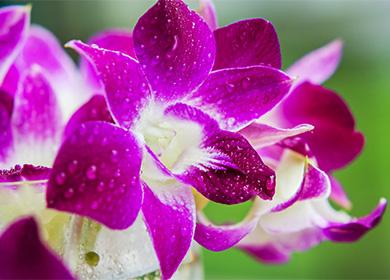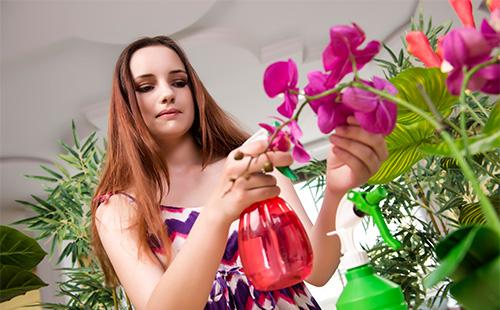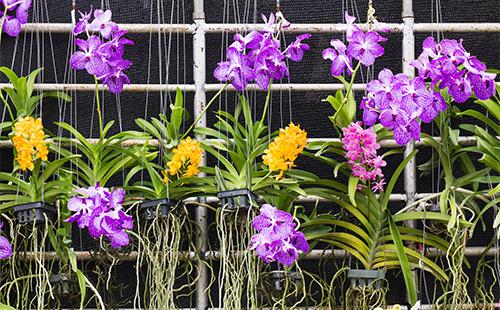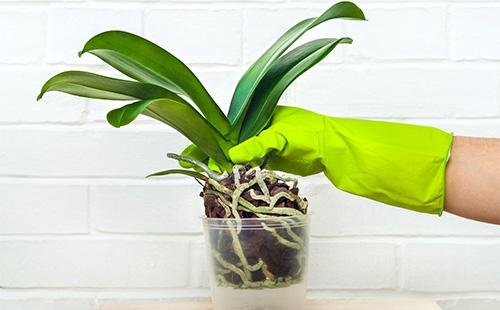The content of the article
Dendrobium (dendrobium) - a small variety of orchids. It is considered an epiphytic plant (uses trees as a support), but can grow on land and stones. The literal translation is "living in a tree." It blooms profusely and for a long time. High peduncle is completely covered with flowers.
Botanical Description
A large genus, including species that are different in structure, size, color. Stems can be fusiform, cylindrical, reed. There are miniature varieties and tall plants up to two meters. At home, usually dendrofalenopsis berry oda does not grow above 60 cm.
- The roots. The aerial roots are well developed, the mix sled arboretum is covered with velomenom - a loose hygroscopic fabric that absorbs and accumulates moisture.
- Leaves. Of various shapes - elliptical, oblong, narrow-lanceolate. Gather in the upper part or grow throughout the stem. There are species with dense succulent (storing moisture) leaves.
- Flowers. Different colors, sizes, shapes, often with a pleasant aroma. A common symptom is that the base of the lip is folded around the column (fused stamens and pestle). The column is short; lateral sepals extend from its base.
- Inflorescences. Pistiform, often multiflorous. They are straight and hanging, apical and lateral. Flowering lasts from two to eight weeks.
Interesting varieties
The most extensive genus among orchids. Includes about 2000 species, many artificial hybrid varieties. The following varieties and varieties are recommended for growing dendrobium orchids at home.
- Dendrobium King. Miniature, beautifully flowering variety. The stems are stiff, cylindrical, thickening at the base. Three to four leaves are concentrated at the top. The flowers are medium-sized, but very fragrant. Inflorescence is a small-flowered brush. Colors range from white to deep purple.
- Dendrobium Lindley. The stem is a low pseudobulb of oblong-rounded shape. On each pseudobulb one sheet is formed. Peduncles long, drooping. The flowers are golden, very fragrant.
- Dendrobium Nobile. A large, very common variety. The stems are fleshy, covered with leathery elongated leaves. The sheets are arranged in two rows. Two-year-old shoots produce small peduncles. Two to three flowers bloom on each of them. The color is multicolor - the edges of the petals are pink or lilac, gently creamy at the base. A purple spot stands out on the white pubescent lip. It is considered an unpretentious view.
- Dendrobium phalaenopsis. Another tall variety with tall sturdy stems. Long lanceolate leaves are concentrated at the top. Peduncles more than half a meter in length. With good care, up to 40 buds can form on one flower arrow. Large flowers are painted in white, pink, saturated red or raspberry color.Long stand in cut.
Common Hybrids
In addition to the main varieties, hybrid varieties deserve attention. They are distinguished by improved characteristics - endurance, long flowering, interesting colors.
- Dendrobium berry ode. A hybrid species of King Dendrobium. One of the most famous hybrids. Color varies from white with a pinkish tinge to dark crimson. It begins to bloom at the end of winter; it finishes only at the beginning of summer. It is very easy to care for and grow, easily adapts to the conditions of the apartment.
- Dendrobium Sa-nuk. Hybrid bred by Thailand breeders. It grows quickly, blooms stably and abundantly. The flowers are small, delicate yellow.
- Hibiki Dendrobium. Differs in slow growth, but very beautiful and long flowering. Two-tone flowers - pink petals combined with a bright orange lip.
- Dendrobium stardust. Stems - thin tall pseudobulbs, segmented. Grow densely, slightly hanging to the sides. The length of the pseudobulbs depends on the light intensity. In the shade they stretch, in bright light they grow shorter and thicker. Leaves of a lanceolate form. Each leaf lives up to three years. During flowering, peduncles appear from the internodes. Each of them carries from one to five flowers. Coloring varies from light yellow to orange with a reddish tint. The lip is covered with darker veins.
- Dendrobium moniliform. A hybrid variety of dendrobium nobile. Miniature plants about 20 cm high. Blossoms in small white or gently lilac flowers.
Flower adaptation after purchase
How to care for dendrobium orchid after purchase? Leaving in the first week in a new place affects the further growth and condition of the plant. Orchids are sensitive to a change of scenery. A week or two will pass before the adaptation of the flower and the beginning of growth. Your task is to help him with this.
- Quarantine. For two to four weeks, the dendrobium is set separately from the rest of the indoor flowers. Choose a shaded, cool place. The room is ventilated daily.
- Top dressing. Fertilizers do not introduce fertilizers during the adaptation period, even if the seller in the store recommended them to you. The flower first needs maximum peace.
- Watering. The first week they do not water the dendrobium, but constantly monitor the condition of its leaves and pseudobulbs. If the substrate is completely dry, the leaves begin to droop, you can moisten the soil a little.
- Pests. In the store you may not notice the initial stages of pest damage. Keeping it dry during quarantine makes it easier to detect. The appearance of a thin cobweb, spots on the leaves - all this indicates the presence of insects. The flower is again carefully examined and treated with insecticides.
Basic care rules
It is believed that caring for the dendrobium is easy. But this is only from the point of view of an experienced grower. Care for any orchid is specific. All varieties, without exception, need systematic, attentive, responsible care.
- Lighting. Keep in good light, but protected from the sun. The best accommodation option is the south window. Other windows require backlighting. Putting on the north window is contraindicated. In the spring, with the onset of stable heat, you can take the dendrobium to the loggia. Fresh air is good for him. Temperature at night should not fall below 7 ° C. Light intensity affects leaf color. Dark green is a sign of a lack of light. With too bright lighting, they become light green.Yellow leaves - a strong deficit of light, dangerous for the plant.
- Temperature. At the stage of active growth, the optimal daily temperature is 25 ° C, and the night temperature is 20 ° C. A daily temperature difference is required - without this, the dendrobium will not bloom. He does not tolerate heat above 30 ° C. In autumn, the temperature is reduced. Daytime should be about 20˚С, night - 10˚С.
- Watering. Watering is plentiful after complete drying of the soil. It is believed that it is correct to water the dendrobium by immersing the pot in a container of warm water for 10-15 minutes. After draining excess fluid, the flower is returned to its original place. With the appearance of new leaves on the tops of the sprouts, watering is temporarily suspended. Renew them only after the appearance of flower buds.
- Humidity. Artificial humidification is required only in the summer. In the heat, dendrobium is sprayed from a small spray bottle with warm soft water. In winter, spraying is not necessary and even dangerous. High humidity in combination with cold leads to rotting of the roots.
- Top dressing. Fertilizers are applied from the beginning of flowering to the final formation of new shoots. Use mineral complexes for orchids. Fertilizers are diluted in water for irrigation. It is sometimes useful to carry out foliar top dressing by spraying. For the first and last feeding, the amount of fertilizer taken is half as much.
- Priming. Universal soil mixtures are unsuitable for planting orchids. Dendrobium is planted in a mixture of peat, pieces of coniferous bark, birch coal and sphagnum moss. Pre-sterilize the substrate - pour boiling water or calcine in the oven. The bark is soaked for two days before being added to the mixture, followed by washing in clean water.
- Transfer. For dendrobium orchid transplantation, good reasons are needed. He endures it very hard. Indications for transplantation - salinization of the substrate, turning it into dust, tightness of the roots. Transplanted in late February or early March.
What is the reason for the lack of flowering
Dendrobium at home does not bloom in violation of the content regime. Incorrect watering, pests, lack of daily temperature fluctuations - all this badly affects the formation of flower arrows and buds. The most common situations are as follows.
- Peduncle is not formed. Instead, new babies are actively appearing. The reason is a lack of light and high air temperature.
- No flowering for more than a year and a half. Dendrobium experiences a constant lack of light or is kept without a period of rest. Coolness and daily temperature changes are the main factors for the successful laying of flower buds.
- The flowers bloom, but immediately dry. The main causes are pest damage, excess moisture and heat.
Features after flowering
From the proper care of the orchid dendrobium after flowering, the further development of the plant depends. Do not rush to cut the peduncle with a pseudobulb - first assess their condition.
Only dried pseudobulbs are removed. A weak but lively pseudobulb can bloom repeatedly. Flowering can be stimulated - reduce watering and spraying, put the dendrobium in a cool place. With the advent of sprouts, watering is resumed. When the sprouts get stronger, the technique is repeated - reduce watering and keep it cool to form flower buds. Re-watering is intensified with the appearance of buds.
Dry pseudobulbs are cut with a sharp, pre-sanitized knife. Slices are treated with charcoal powder, sulfur or sprinkled with ground cinnamon. Some gardeners prefer gardening.
Breeding methods
Dendrobium orchid can only be propagated vegetatively. Seed propagation is not usually used due to slow growth. Obtaining seed from your plant is difficult and useless. Domestic seeds of hybrid varieties do not carry the characteristics of the varieties of the mother plant. Three methods are used.
- By the kids. Children are formed in the upper part of the pseudobulb. Over time, they start their own roots. When their length reaches 5 cm, the dendrobium baby is carefully cut with a sharp knife along with the roots. Before planting, the shoot is dried for several days in a shaded, well-ventilated place. Rooted in a shallow pine bark. The conditions for successful rooting are bright light, air humidity 70%, temperature 20-25 ° C. The dendrobium from the baby blooms after two years.
- Cuttings. A whole pseudobulb is separated, cut into 10 cm pieces. Slices are sprinkled with coal powder, the cuttings are dried in fresh air. Rooting is better in sphagnum. A container with cuttings is covered with a film on top to create greenhouse conditions. Keep under diffuse lighting, warm, regularly ventilate. Moss, if necessary, moisten from a spray bottle. Two months later, transplanted to a permanent place. The first flowering occurs in two to four years.
- By dividing the bush. You can plant dendrobium at home by dividing the mother plant. It must meet a number of requirements - age from four years, good conditions of detention, the presence of six or more pseudobulbs. Division combine with transplant. The roots are freed from the substrate, cut with a sharp knife. Two or three pseudobulbs with roots are left in the divide. Slices are treated with cinnamon or charcoal powder and planted.
Diseases and possible growing problems
Most of the difficulties are the result of improper growing conditions. The plant weakens, resistance to diseases and pests decreases. The table shows the signs for determining the errors of care or the presence of pests.
Table - Problems encountered by flower growers when growing dendrobium orchids, and their possible causes
| Problem | Possible reasons |
|---|---|
| Grayish-brown leaves with a silvery sheen | - thrips |
| Drying and falling leaves | - Scaffold; - humidity below 40%; - prolonged lack of watering |
| Puckering Pseudobulbs | - A natural phenomenon during the growth of new shoots; - long-term lack of moisture |
| Active formation of children, lack of flowering | - Non-compliance with the conditions of the rest period; - wrong watering mode |
| Pseudobulb brown or yellow | - Rotting roots |
| Young shoots grow thin | - Normal |
When pests appear, the treatment of orchid dendrobium is reduced to processing with insecticides. If there are few insects, they disappear after the first treatment. In advanced cases, triple processing with weekly intervals is indicated. Other problems are eliminated by adjusting care.
Growing dendrobium may seem difficult only in the first year. It is worth understanding the essence of care, the needs of the plant and everything will become much easier. Proper orchid care dendrobium guarantees abundant and regular flowering.




